Text
Week 11
Implementation Phase
This week, I continue working on the final product and making design changes.
Things I've done this week:
Prototype Making
Reflections/thoughts/feelings on what I've done based on the reflection framework of What? So What? Now What?(Rolfe et al., 2001) :
What?
When I started felting wool this week, I began following last week's "Now What?" by spending 15 minutes testing the coarse felting needles. These needles are sturdy and suitable for working with coarse fibres and attaching parts securely. However, it is not suited to detail or neat surfaces, so it could be more helpful for my future wool felting projects since I already finished my shopping bag making (see Figure 1). Otherwise, when using wool felt to create the slogans on the finished product, I found it challenging to make clear letters with the wool felt technique.
Figure 1
Shopping Bag

Note. The photos of what my final shopping bag design looks like. Own work.
However, when using wool felt to make the slogans on the finished product, I needed help to make clear letters with the wool felt technique. After repeating my attempts four times and never getting the desired result, I was devastated and angry. I was more anxious than ever and cried for a long time because I had two weeks to deliver the final product.
So What?
After I calmed down, I decided that the objective reason for this predicament was that poking a clear font with a needle in a limited area is time-consuming and labour-intensive, and rendering a clear and readable font is hard. The subjective reason was my inability to accept the imperfections of my project and the fact that things didn't go as expected. After realizing this, I decided to stop striving for perfection or dwelling on the anxiety of being unable to control where things were going and think of ways to accept the situation and solve the problem.
The most realistic solution would be to modify some of the designs to make it easier for me to make clear letters. So, I changed the design to "sustainable seafood" because the fish's body was too small to fit all the "sustainable seafood consumption" letters (see Figure 2). Meanwhile, even fine felt needles could not make the first version of the scallop clear enough to hold all the text, so I widened one side to make it big enough to have all the letters (see Figure 2). Besides, since the squid's head is so tiny, I changed it to having the squid hold up the notice board and place the text on it so there would be plenty of space (see Figure 3). The original round badge couldn't accommodate all the text, so I removed the unnecessary letter "our" (see Figure 4).
Figure 2
The fish and scallop

Note. The photo shows my design changes for the fish and scallop. Own work.
Figure 3
The squid

Note. The photo shows my design changes for the squid. Own work.
Figure 4
The round badge

Note. The photo shows my design changes for the round badge. Own work.
This experience has taught me that in any future design project, I must accept all changes calmly. In the face of unexpected problems, a professional designer must calmly and quickly decide on a solution.
Now What?
After I realized the importance of having the above awareness and mindset, I made two decisions. The first was to handle whatever happened during the next two weeks of the program smoothly and calmly and continue with the program as planned. Whenever an uncontrollable emotional outburst occurs, I will ask myself, "What are the three things I've seen so far," or "What are the three sounds I've heard so far?" or touch and smell three things to distract and calm down. The second is to review these self-questions from this blog every time I get emotional about other projects in the future.
Reference
The University of Edinburgh. (2020, January 30). What? So what? Now what? The University of Edinburgh. https://www.ed.ac.uk/reflection/reflectors-toolkit/reflecting-on-experience/what-so-what-now-what
Borton. T. (1970). Reach Touch and Teach: Student Concerns and Process Education. McGraw-Hill, New York
Driscoll J. (1994). Reflective practice for practise. Senior Nurse, 13, 47-50
Rolfe, G., Freshwater, D., Jasper, M. (2001). Critical reflection in nursing and the helping professions: a user’s guide. Basingstoke: Palgrave Macmillan.
0 notes
Text
Week 10
Implementation Phase
This week, I entered the Implementation phase of my project, and my energies are mainly focused on making the final product.
Things I've done this week:
Define my Treaty Partnership and Whare Tapa Whaa
Prototype Making
Reflections/thoughts/feelings on what I've done based on the reflection framework of What? So What? Now What?(Rolfe et al., 2001) :
What?
I began by analysing the strengths and weaknesses of my project in different areas of well-being based on Whare Tapa Whaa(see Figure 1&2). My project focuses on seafood sustainability, taha whenua, and ecological balance in New Zealand, but not so much on the local community's mental health. Meanwhile, I thought about how to be a strong tangata tiriti and treaty partner in the project and implement these behaviours (see Figure 3).
Figure 1
Whare Tapa Whaa Form

Note. This form shows how my project is connected with the Whare Tapa Whaa. Own work.
Figure 2
Whare Tapa Whaa Rader Chart

Note. This chart shows how deeply my project is connected with the Whare Tapa Whaa. Own work.
Figure 3
Treaty Partnership

Note. This form shows how I will achieve The three "P's". Own work.
After that, I mainly focused on making the final product. Since wool felting is very time-consuming and requires a lot of patience, I initially chose a medium felting needle with barbs on three sides. This type of needle is suitable for making the body of a three-dimensional piece and holds the piece equally well, and I have used this needle for other artworks before (see Figure 4).
Figure 4
Past Artworks

Note. My past wool felting artworks. Own work.
However, based on last week's experience, I spent 15 minutes testing the tool before making it official. During the test, I realised this needle was unsuitable for detailed work. This was unexpected, but I no longer feel anxious or panicked by this unplanned situation. During this project, I gradually learned to face the problem head-on calmly. After all, it's the norm not to go as planned.
So What?
Realising this, I felted the body of all my designs with medium gauge felting needles and then used fine gauge felting needles for details such as the Māori patterns (see Figure 5), the eyes of a fish and the texture of a squid (see Figure 6), etc. Fine felting needles are unsuitable for coarse fibres or rough carving/roughing but ideal for detailing and getting a neat finish.
Figure 5
Māori Patterns

Note. The Māori patterns I used for my shopping bag. Own work.
Figure 6
Fridge Magnets / Badges Making Process

Note. The photo shows how I made the eyes of a fish and the texture of a squid step by step. Own work.
After having this week's experience, I realised the importance of using the right tools and the need for weekly reflection. It also proved that the “future actions” I decided to take last week were practical and saved me a lot of time and energy. Apart from that, it also taught me to learn from my experiences on time.
Now What?
Over the next few weeks, I will follow the action guide made by Week 9 and try out what I can achieve with different tools for 20 minutes, choosing the one that gives the best presentation before making the felted wool artwork and then making the finished product. Now that I have experience with three types of felting needles, I need to test out the coarse felting needles next time. In the meantime, no matter how busy or tired I am, I try to keep a detailed record of my weekly reflections and make valid "Now What?" actions.
Reference
The University of Edinburgh. (2020, January 30). What? So what? Now what? The University of Edinburgh. https://www.ed.ac.uk/reflection/reflectors-toolkit/reflecting-on-experience/what-so-what-now-what
Borton. T. (1970). Reach Touch and Teach: Student Concerns and Process Education. McGraw-Hill, New York
Driscoll J. (1994). Reflective practice for practise. Senior Nurse, 13, 47-50
Rolfe, G., Freshwater, D., Jasper, M. (2001). Critical reflection in nursing and the helping professions: a user’s guide. Basingstoke: Palgrave Macmillan.
0 notes
Text
Week 9
Ideation Phase
This week, I prepared the materials for the final product and thought about what tools and processes I should use. After that, I started the process of making it.
Things I've done this week:
Chose materials, crafts and tools
Made shopping bag
Started wool felting
Reflections/thoughts/feelings on what I've done based on the reflection framework of What? So What? Now What?(Rolfe et al., 2001) :
What?
Since the main craft I will be using for my final product is wool felting, I started by purchasing the corresponding wool colour based on the design. Then, I chose the tools I would use (see Figure 1), such as felting needles, fabric, foam boards, etc. In the meantime, I made shopping bags using jute, string and a sewing machine (see Figure 2). According to the feedback from the peers' user testing, I chose the jute fabric over the canvas fabric because the shopping bag made of this fabric can fulfil the conditions of being easy to clean up and dry fast anytime and being able to stand upright by itself.
Figure 1
The materials and tools of wool felting

Note. The photo of what materials and tools I used for wool felting. Own work.
Figure 2
Shopping bag making process

Note. The photo of how I made shopping bag. Own work.
I first considered using the wet felting process that combines friction/agitation, soap and water to make felt out of wool fibres. This method would be a great time and material saver when making large felted wool paintings. However, after applying it, I found it difficult to dilute the soap and water to the right proportions, especially since this was my first wet felting. In addition, wet felting makes it very difficult to carve out the exact details of the Maori pattern. I felt frustrated and anxious because of the pre-preparation and actual operation I had spent a long time on but failed.
So What?
After resting and reflecting, I thought this was because I didn't choose the suitable wool felting method. So I immediately switched to needle felting, a technique I've used so many times that I'm proficient at it. I chose a needle felting punch with seven needles for the bottom felted patch, medium felting needles for the surface and fine felting needles for the pattern details. The judicious use of different types of felting needles helped me accomplish a lot of my desired progress quickly while presenting better pattern details (see Figure 3).
Figure 3
Needle Felting

Note. The photo of how I used needle felting to make my final outcome. Own work.
After overcoming this week's difficulties, I realized the importance of using the right tools and process methods. In a more pressing project, it is sometimes better to go with what you are already familiar with rather than trying new techniques and learning new things, which saves time and effort.
Now What?
After realizing all of the above, I decided to try out what I could achieve with both needle felting and wet felting in 20 minutes before making wool felting artwork over the next few weeks, choosing the one that presented the best results before making the finished product. It will help me to decide which technique I should use in a short time.
Reference
The University of Edinburgh. (2020, January 30). What? So what? Now what? The University of Edinburgh. https://www.ed.ac.uk/reflection/reflectors-toolkit/reflecting-on-experience/what-so-what-now-what
Borton. T. (1970). Reach Touch and Teach: Student Concerns and Process Education. McGraw-Hill, New York
Driscoll J. (1994). Reflective practice for practise. Senior Nurse, 13, 47-50
Rolfe, G., Freshwater, D., Jasper, M. (2001). Critical reflection in nursing and the helping professions: a user’s guide. Basingstoke: Palgrave Macmillan.
0 notes
Text
Week 8
Ideation Phase
During the week, I got feedback from tutors, peers and partners about my paper prototype.
Things I've done this week:
Revised my HMW, Design Vision and Target Audience
Get feedback from Tutor and Partner
User testing with my peers
Reflections/thoughts/feelings on what I've done based on the reflection framework of What? So What? Now What?(Rolfe et al., 2001) :
What?
I started by identifying my target group (see Figure 1) based on the context of my project and modified my design vision (see Figure 2). With the help of the stream leader, I revised my HMW statement to be "How might we promote sustainable seafood production that upholds the tiakitanga through sustainable consumption behaviours and health awareness?" Based on the feedback I got from the tutor, I discarded the seafood consumption guidebook because it's not very useful, and people may not read it but throw it away when they receive it. Besides, the feedback I got from my partner was excellent. She confirmed my project concept, thought raising consumers' awareness of sustainable consumption through everyday objects was good, and encouraged me to continue the project. I feel happy and accomplished. According to the planned methodology timeline, I was supposed to use the "Top Five'' method (IDEO, 2015) to pick the top five ideas I was interested in (see Figure 3). However, this still centred around my thoughts rather than the audience's ideas. After realising that, I had a User Testing with my friends within the 301/302 course, asking them for some ideas for improvement and inviting them to vote for a few designs they did like.
Figure 1
Target Audience

Note. The photo of what my target audience is and why I choose them. Own work.
Figure 2
Design Vision

Note. The photo of what my design vision is. Own work.
Figure 3
Top Five

Note. The photo of what my top five choices are by using the method of "Top Five". This method From The Field Guide to Human-Centered Design (1st edition), by IDEO, 2007 (https://www.google.co.nz/books/edition/The_Field_Guide_to_Human_centered_Design/-T3urQEACAAJ?hl=en). Copyright 2007 by IDEO.
So What?
I made that choice because my experience in week 6 taught me to predict in advance how well each method would work, and choosing the suitable method helped me to think deeply about the direction I was going in and saved me a lot of time. After predicting that the method would not work as expected, I conducted a User testing combining personal and classmate choices (see Figure 4). At the same time, I additionally gained everyone's necessary considerations about badges and shopping bags.
Figure 4
Peer User Testing

Note. The photo of what my user testing feedback is from my peers in DES301/302. Own work.
This experience also proved to me the need and importance of reflection. Regularly stating weekly experiences and summarizing what I have learned and experienced will help in future learning journeys.
Now What?
I realized the significance of writing a weekly reflective blog. In the following weeks, I will still predict how well each method will be used and adjust accordingly. At the same time, I will carefully complete the weekly blog and record my thoughts and learnings at that moment.
Reference
The University of Edinburgh. (2020, January 30). What? So what? Now what? The University of Edinburgh. https://www.ed.ac.uk/reflection/reflectors-toolkit/reflecting-on-experience/what-so-what-now-what
Borton. T. (1970). Reach Touch and Teach: Student Concerns and Process Education. McGraw-Hill, New York
Driscoll J. (1994). Reflective practice for practise. Senior Nurse, 13, 47-50
Rolfe, G., Freshwater, D., Jasper, M. (2001). Critical reflection in nursing and the helping professions: a user’s guide. Basingstoke: Palgrave Macmillan.
Marks, J. (2021). Healthy People, Healthy Ocean: How Conscious Consumers Are Helping Build a More Sustainable Seafood Sector. Sustainable Brands. https://sustainablebrands.com/read/behavior-change/healthy-people-healthy-ocean-how-conscious-consumers-are-helping-build-a-more-sustainable-seafood-sector
IDEO. (2015). The Field Guide to Human-Centered Design (1st edition). San Franciso:IDEO. https://www.google.co.nz/books/edition/The_Field_Guide_to_Human_centered_Design/-T3urQEACAAJ?hl=en
0 notes
Text
Week 7
Ideation Phase
This week, I put my idea into action for the first time by making the paper prototypes.
Things I've done this week:
Create Moodboard and Material Exploration
Draw prototype sketch
Make paper prototypes
Reflections/thoughts/feelings on what I've done based on the reflection framework of What? So What? Now What?(Rolfe et al., 2001) :
What?
I began by looking up existing examples of finished products based on ideas I already had. After observing their design approach and style, I summarised the art style that would suit my project and created my Moodboard. After that, I researched the types of magnets used to make the fridge stickers, the various pins used for the badges, and the types of fabric used to make the shopping bags. Since my main task is making paper models, I'll experiment and explore different materials in more depth in later weeks. Otherwise, after considering the effects that other materials would show, a lot of inspiration came to my mind, and I sketched these. Based on these drafts, I made two conceptual models using wool felt. However, they were unreadable, took a long time to make, and were not very user-friendly to understand what I was trying to convey. I felt anxious and rushed because my friends had finished most paper models.
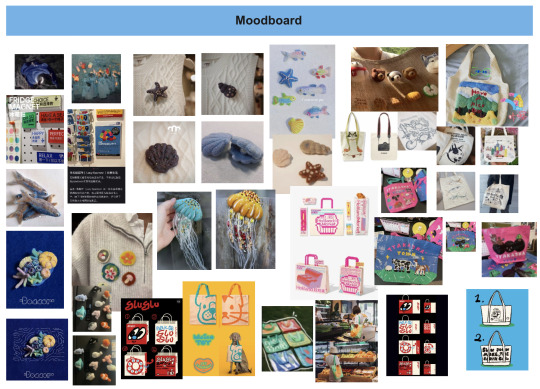

So What?
This predicament is because I was lazy and didn't draw more envisioned details such as fonts, colours, slogans, etc. I used Procreate to draw more details on my iPad and printed them on A4 paper. I think the advantages of this drawing app are that it covers a large number of drawing brushes, is easy to colour, dramatically reduces the time spent on using different tools in reality and is much faster and more convenient to use than Ai; the only disadvantage is that it doesn't have the same smoothness and realism as hand-drawn drawings. Additionally, I cropped the printout and used a Hook&Loop sticker to adhere it to the painted background, creating the feel of a removable refrigerator sticker and badge.
(Sketch + Paper Prototype)
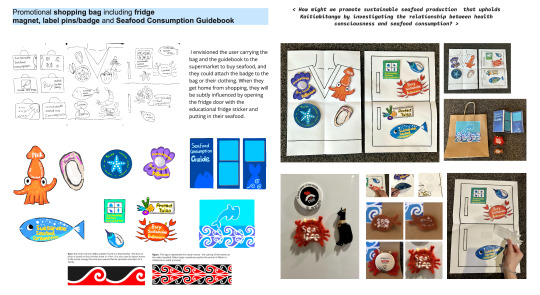
This experience reflects the importance of preparing in advance. Because I wanted to finish the paper prototype quickly, I was lazy and did not draw more detailed sketches, but the result that it took more time will also have a bad emotional impact on me.
Now What?
I realised that being well-prepared and implementing actions can often be twice as effective. In the next step of prototyping, I will make at least five sketches before I put them into action. At the same time, I will think of various forms of expression, try out different possibilities, and choose the most appropriate one after I have prepared at least three ways.
Reference
The University of Edinburgh. (2020, January 30). What? So what? Now what? The University of Edinburgh. https://www.ed.ac.uk/reflection/reflectors-toolkit/reflecting-on-experience/what-so-what-now-what
Borton. T. (1970). Reach Touch and Teach: Student Concerns and Process Education. McGraw-Hill, New York
Driscoll J. (1994). Reflective practice for practise. Senior Nurse, 13, 47-50
Rolfe, G., Freshwater, D., Jasper, M. (2001). Critical reflection in nursing and the helping professions: a user’s guide. Basingstoke: Palgrave Macmillan.
0 notes
Text
Week 6
Ideation Phase
As the last week before the holidays, this week is mainly used to brainstorm, revise and decide on a final plan.
Things I've done this week:
Defined Final Concept Plan
Filled Flesh It Out
Filled Whānau matrix
Reflections/thoughts/feelings on what I've done based on the reflection framework of What? So What? Now What?(Rolfe et al., 2001) :
What?
As I mentioned last week, I reversed my existing plan ABC and brainstormed with my friends to refine and find what I was interested in. I presented them with topics I was interested in, such as designing everyday objects that would be usable, and areas I specialize in, such as wool felting, video editing, programming, ceramics, graphic design, etc. I found a way to make the most out of it and made it work. After discussing with them and getting their feedback, I decided to design a sustainable seafood-themed shopping bag with a fridge sticker, badge and sustainable seafood guidebook. I envisioned the user carrying the bag and the guidebook to the supermarket to buy seafood, and they could attach the badge to the bag or their clothing. When they get home from shopping, they will be subtly influenced by opening the fridge door with the educational fridge sticker and putting in their seafood.

After setting my goals, I finally felt relaxed and confident. It meant that I was back on the right track, and the gap with the rest of my classmates was not that big. I began by visualizing the plan using Flesh It Out to make a rough version. The advantage of Flesh It Out was that it helped me add visual details to the project, and by searching for similar examples, I could make the idea more complete while gaining a lot of inspiration. However, the dilemma I find myself in is connecting this new plan and my "how might we", "vision", or kaitiakitanga more deeply.

So What?
This situation is because only using Flesh It Out is somewhat restrictive. So I searched for a long time and additionally used the Whānau matrix, which can genuinely connect three parts: Nga Tangata (people), Taiao(environment) and Whenua(place and the community in that place). Using this method helped me to explore more deeply the benefits of my concept for people, the environment and the community and to think about what other potential advantages I could optimize and create.

This experience taught me that adding a new method could refine the limitations of using a particular method. I can think ahead at each stage of using a specific approach about the advantages and disadvantages of that method and prepare more alternatives or methods that can be used together, saving more time and effort.
Now What?
I realized that predicting the impact of using each method ahead of time would be a huge time saver and that using the suitable method would help me think deeply and sort out my direction. Next week, I will devise 2-3 alternative or collaborative choices for each method I plan to use in the ideation and implementation phases.
Next Step
At the same time, I decided to continue to revise and refine my HMW and vision connected to my positionality throughout the project based on the Community stream's rubric, exploring how my project can positively impact the Whare Tapa Whaa well-being of the community.
Critically think about my journey as Tangata Tiriti and reflect on what this means regarding upholding partnership, protection and participation with my work, tangata whenua and everyone in the local community.
Reference
The University of Edinburgh. (2020, January 30). What? So what? Now what? The University of Edinburgh. https://www.ed.ac.uk/reflection/reflectors-toolkit/reflecting-on-experience/what-so-what-now-what
Borton. T. (1970). Reach Touch and Teach: Student Concerns and Process Education. McGraw-Hill, New York
Driscoll J. (1994). Reflective practice for practise. Senior Nurse, 13, 47-50
Rolfe, G., Freshwater, D., Jasper, M. (2001). Critical reflection in nursing and the helping professions: a user’s guide. Basingstoke: Palgrave Macmillan.
0 notes
Text
Week 5
Ideation Phase
This week is primarily used for reflection and deeper dissection of the project plan.
Things I've done this week:
Finished DES 302 Slides & Script
Wrote Ethics Considerations related to Secondary Search
Filled Empathy Map
Get Blog Feedback
Reflections/thoughts/feelings on what I've done:
During this week, I received feedback about my blog which the tutor suggested that I needed to reflect more deeply on the choices I made, e.g. what were the pros and cons of the options I made, what alternatives were considered during the period of making the final decision and why did I make the choices I did in the end. To help myself think more deeply about direction and reflective structure. I decided to use Rolfe et al's (2001) reflective model 'What? So What? Now What?' as the template. It is simple to remember and understand, can be used for reflecting on experiences in a wide range of domains, and is easier to pick up and follow than other reflective templates. To ensure the depth and breadth of the blog, I will be answering the following questions simultaneously as an aid.


What?
I received a grade for the overall DES302 proposal presentation, which was good, but I wasn't pleased with the score for the ETHICS section. I spent the day thinking about and looking up ethical considerations related to the secondary research which I had considered in great detail. However, the feedback I received was "Limited plan for ethics if approval was necessary for the project". I was shocked and frustrated and felt as though no matter how hard I tried, I seemed to fall short of the assignment's requirements, making me very anxious even as I wrote this blog. I am unsure of getting it right, stressed out and feeling like everything I do is wrong because I am a person who needs positive feedback very much to keep working. When told by my teacher that we needed to decide to move forward with a plan this week and delve into the steps and concept development to make it happen, I found that I was disinterested in all of the existing Plan ABC. I'm not good at or enjoy UI/UX design, as opposed to designing and handcrafting actual things. These situations made me feel even more anxious and confused, like a train on the wrong track.

I initially filled out the empathy map as planned to keep myself from dwelling on negativity. The advantage of this method is that it helps me to gain insight into the reasons behind specific actions taken by my potential audience and build empathy for them without violating ethical norms. The disadvantages were that the model needed to be more complex, and we could not collect primary data. My assumptions were not based on reliable user data and were most likely inaccurate.

So What?
These experiences tell me I need more time to think deeply about the content. I was so stressed out when I was conceptualising my Plan ABC and Ethical Considerations that all I could think about was, "How can I get these assignments done and submitted quickly and timely?". At the same time, because of my superficial approach and shallow perception of these, I've avoided getting feedback from my friends, even if it would have been helpful because I'm not confident deep down. I know my problems, but I want to avoid facing them because being lazy up front means there's a lot of refining and fixing to be done in the future.
Overall, I end up getting frustrated with myself because I'm always rushing to accomplish things that are too much trouble and too complicated, and I don't set aside enough time to think deeply about them and get them right. I need to force myself to face up to difficulties and find a way to solve them instead of avoiding them and to allow enough time to complete tasks or receive feedback from others.
Now What?
I have to develop better project planning and time management in future projects. Ensure I have enough time to think deeply, prepare, and receive feedback from others.
For future project phases, I will set specific dates ahead of time for what needs to be done and set reminders on my phone. I will then plan with my friends and use Discord's voice calls and screen sharing to check each other's progress weekly so that I can revise any issues I find on time. This action plan will motivate me to start earlier, give me more time to think deeply and take the pressure off of me regarding implementation.
Reference
The University of Edinburgh. (2020, January 30). What? So what? Now what? The University of Edinburgh. https://www.ed.ac.uk/reflection/reflectors-toolkit/reflecting-on-experience/what-so-what-now-what
Borton. T. (1970). Reach Touch and Teach: Student Concerns and Process Education. McGraw-Hill, New York
Driscoll J. (1994). Reflective practice for practise. Senior Nurse, 13, 47-50
Rolfe, G., Freshwater, D., Jasper, M. (2001). Critical reflection in nursing and the helping professions: a user’s guide. Basingstoke: Palgrave Macmillan.
0 notes
Text
Week 4
Inspiration Phase
I finally got to take a breather and rest this week that made me feel relaxed.
Things I've done this week:
Finished DES 301 Assignment Two Submission
Completed the presentation slides
Wrote the presentation script
Finished the collage
Reflections/thoughts/feelings on what I've done:
My main task this week was to complete the presentation. As someone who doesn't like to talk or socialise, this gives me a lot of anxiety. To overcome this, I started by creating the slides I would use in my presentation based on the artistic style I wanted to use. After that, I wrote my presentation script based on the project introduction, HMW statement, values, Methodology, preliminary research, hypothetical vision, scope/limits of your project, and timeline of these aspects.
During my presentation, I used the Hover Clock app to time myself to get a handle on how fast I was speaking. After completing the presentation, my teacher gave me feedback that I could improve my communication skills to overcome the speech impediment and have more eye and body interaction than reading from a mobile phone. The truth is, even when using my native language, I don't want to talk. But I'll practise more because talking more will reduce mental barriers like nervousness. As a first step to practice, my friend and I started by communicating more in English about everyday topics or our understanding of the requirements of projects and assignments, talking about which is easier to achieve in campus life.


In addition to this, I used the collage method. According to IDEO (2015), the audience group can express their ideas and vision of the finished project through collage. The advantage of using this method is that it provides an intuitive and concrete understanding of the audience's preferences and tendencies. The disadvantage is that it can violate ethical requirements. Therefore I have chosen to change this method to using collage to express what product style I want to make. I felt very relaxed while using the method as I enjoyed the hands-on activities I could do, which gave me a sense of satisfaction and achievement.

Reference
IDEO. (2015). The Field Guide to Human-Centered Design (1st edition). San Franciso:IDEO. https://www.google.co.nz/books/edition/The_Field_Guide_to_Human_centered_Design/-T3urQEACAAJ?hl=en
0 notes
Text
Week 3
Inspiration Phase
I've done much work this week, refined my Miro board, clearly understood my project goals, produced a detailed timeline, and became more confident and tightly organised.
Things I've done this week
Define my final PlanA,B,C to a project timeline
Define final methods
Inspiration Research - Case Study, Precedent Projects, Moodboard
Complete 8 Ethics Modules
Reflections/thoughts/feelings on what I've done:
During the week, based on my Plan A draft, I completed the Plan B and Plan C drafts. The stream leader's feedback was that these plans need to be narrowed down step by step to achieve the goal. So I set two intervals of ambitious to achievable, interested and uninterested, and wrote down all my ideas within that range. With this, I clarified my final Plans A, B, C and planned a 14-week timeline for each. Because I'm very bad at time planning, creating a timeline was a pain in the arse, and this was my first challenge of the week. I overcame this problem by asking for help from my co-team members, who provided me with many valuable ideas and suggestions, such as completing the Plan A timeline first and adjusting the remaining two timelines based on that. And how to allocate the tasks in the weekly To-do-list to different stages in the timeline.

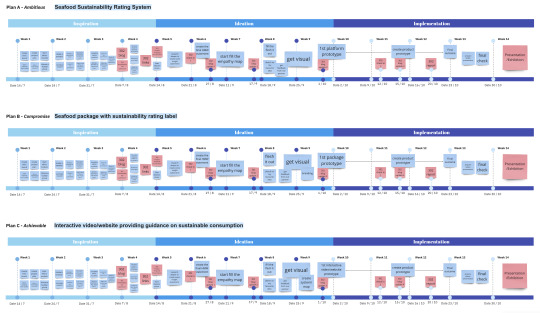
I have identified and refined the METHODS that will ultimately be used in the project by reviewing the human-centred design toolkit. For ethical considerations, I will no longer use focus groups and workshops and have amended how some methods will be used. In the process, I have replaced or added to many of the methods and have gained a deeper reflection and understanding of these methods. Ultimately, I allocated a new timeline for these methods, so I would know when to use them to complete weekly tasks, which made me happy because I wasn't overwhelmed anymore.

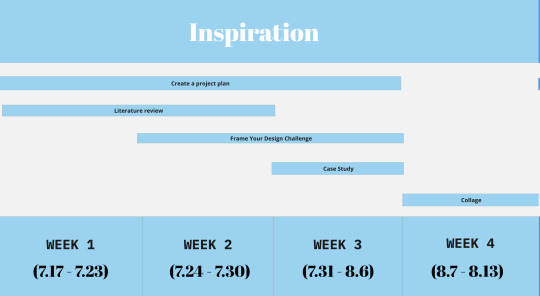


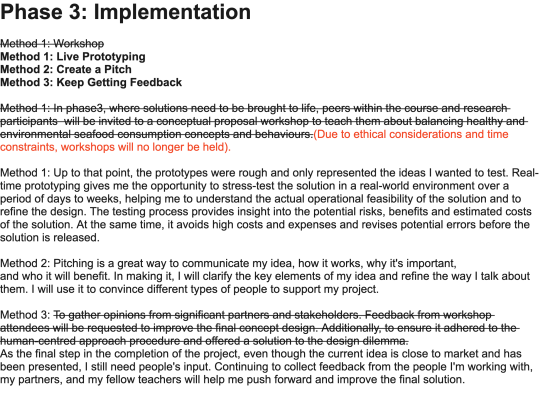

I was excited to explore existing examples of projects and case studies, and I always benefit from looking at what others have done. I was most impressed with the Seafood Watch website as it contained all the pages I wanted to design and provided a detailed guide to sustainable seafood consumption, which was an excellent reference. In addition, I took a lot of inspiration from it and created my first mood board, in which I included a lot of Māori patterns. To honour the principles of Kaitiakitanga and respect the wisdom of the indigenous communities, I will be doing in-depth research and learning about the local Māori and other indigenous groups who have historically used sustainable fishing techniques during the project. By incorporating this historical and traditional knowledge, I hope to preserve cultural heritage while protecting marine resources, as I want my art style to connect with the local culture.


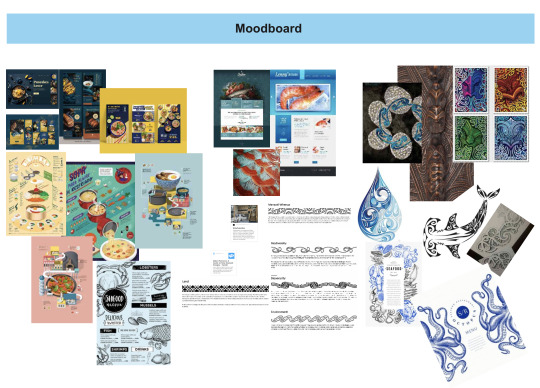
In the end, I completed eight ethical templates.I no longer feel scared and anxious, as before I was always worried that I would break one. I now have a very clear understanding of what I should avoid and will be adhering to the ethics in the coming weeks.
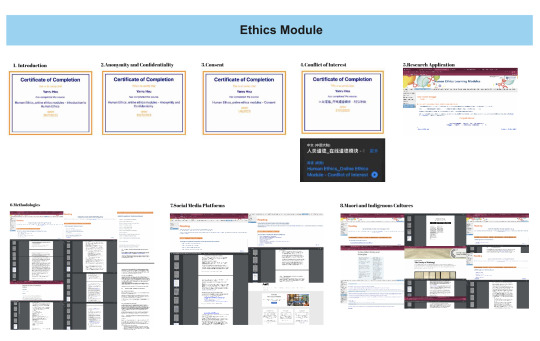
Miro Board:https://miro.com/app/board/uXjVM11INM4=/?share_link_id=263290471997
0 notes
Text
Week 2
Inspiration Phase
This is the week to get some head start on the project and have some idea of what all the project requirements are.
Things I've done this week:
Updated my project timeline - Make 2nd draft of design methodology and the stages of the methodologies to a timeline
Developed a hypothetical vision
Finished two ethics modules
Start on my plan A, B or C draft
Reflections/thoughts/feelings on what I've done:
Last week I worked on fleshing out my Inspiration, Ideation and Implementation method phases. At the same time, I was hesitant to plan this way. Because the framework is too concise compared to hautu waka and double diamonds, I wonder if this is the right one. This week, I got confirmation from my stream leader and used the methods in the IDEO toolkit to help me plan my project schedule in stages. This has given me a much better idea of what I need to do each week and has made it easier to complete tasks, giving me more confidence whilst wasting less time.
Based on my research project, I've developed a hypothetical vision, but I need to figure out what specific things I can design to realise my vision. For the "platform" in my vision, I can only conceptualise app and website-related UI/UX designs for now. But I need help to achieve responsible seafood consumption habits and implement the values of kaitiakitanga in any of these design ideas.
I've started to complete some ethical templates, which have helped me to have specific and detailed knowledge of the ethical considerations in the project. I'm no longer afraid that some of my actions will cause the project to fail because I've broken some rules. It's helped me to be less anxious and panicky about what I'm doing.
As stated before, I was at a loss to realise my vision. I wasn't sure what kind of product I wanted to design, so I synthesised all the assumptions I had made in my proposal. I developed my ambitious plan A: Build an Educational Platform to Raise Awareness, Establish a Seafood Sustainability Rating System, Foster Collaboration with Seafood Suppliers and Retailers, Empower Health-Conscious Consumers, Engage with Indigenous Communities, and Facilitate Behavioural Change through Incentives. But because it's so ambitious, it's making me even more confused because I need to figure out how to make a plan B and plan C that I can achieve based on this anymore.
I will continue to complete the ethical template, refine my plans, and begin to organise the artistic elements, such as my mood board. I plan to update my blog every Sunday or Monday.

0 notes
Text
Week1-1.5
Inspiration Phase
In the first week I had a basic understanding of the overall project requirements and a generalised review of the project in its infancy from last semester, and I felt lost. I didn't have much to write about in the first week, so I combined the first week and the first week and a half.
Things I've done this week:
Review the previous project proposal and summarise the important points
Create a Miro board
Modify my HMW
Define my design methodology as Human-centred Design
Make a timeline draft based on the methodology and weekly To-do-list
Define the scope/limits of my project.
Reflections/thoughts/feelings on what I've done:
I've always struggled with making schedules because I'm a big procrastinator and rely a lot on my mood at the time to get things done. I decided to make smaller, easier-to-complete tasks that would enhance my sense of achievement and allow me to stick to the plan all the way through.
As there are only three stages in my chosen method, how to make it more detailed and specific, asking fellow students using the same method and stream tutors to help me.
I felt anxious and panicky about the limitations imposed by the code of ethics. And how I make any possible solutions regarding my project in the limited 13 weeks available.
To implement the Kaitiakitanga values in my project, I need to learn more about them and seek professional advice.
Wish me luck for the next 13 weeks!

1 note
·
View note